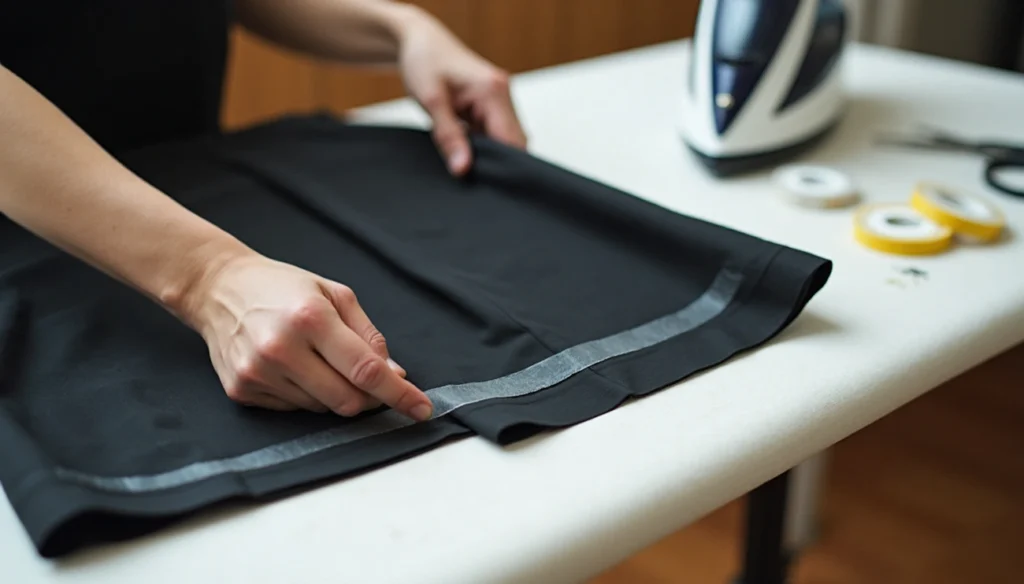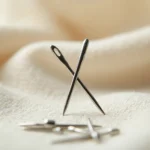Yes, Hem tape works on polyester if applied with the correct heat setting and pressure. Polyester requires a medium heat (around 270–300°F) to bond without melting the fibers. Using a pressing cloth prevents heat damage, and washing the garment in cold water helps the hem tape last longer without peeling.
Can You Use Hem Tape on Polyester?
The short answer is yes, hem tape can definitely be used on polyester fabrics. Polyester is one of the most common fabrics for which hem tape is specifically designed. Nevertheless, there are some important considerations to keep in mind before reaching for your iron and tape.
Why polyester needs special care
Polyester fabrics present unique challenges when it comes to hemming. Primarily, polyester has a significant amount of “bounceback” when pressed. This means that after you iron a crease into polyester, the fabric has a tendency to return to its original shape unless handled properly.
Another critical characteristic of polyester is its heat sensitivity. Since polyester is a synthetic material made from petroleum-based products, it can melt or become damaged if exposed to excessive heat. This makes the ironing process particularly delicate when working with polyester garments.
Additionally, polyester can ravel quite extensively at the edges. Without proper finishing, a polyester hem might quickly fray and unravel, ruining your garment’s appearance and structure.
To combat these challenges when using hem tape:
- Always check if your polyester garment can withstand ironing before applying any heat-activated hem tape
- Set the correct temperature on your iron specifically for polyester (typically a low to medium setting)
- Consider using a pressing cloth between your iron and the polyester fabric for extra protection
- Allow the fabric to cool completely before handling to help “set” the crease
Types of hem tape that work on polyester
Several varieties of hem tape work effectively on polyester fabrics. Understanding the differences helps you choose the right option for your specific project:
Regular weight fusible hem tape is specifically designed for lighter fabrics including polyester blends. Products like HeatnBond Hem Regular Weight are suitable for “cotton, rayon, polyester blends and acrylic fabrics”. This type creates a permanent bond without any sewing required.
Double-sided polyester film tapes with acrylic adhesive provide excellent adhesion to polyester. These tapes bond exceptionally well to most materials and offer resistance to heat, UV exposure, and water vapor. They’re particularly useful for more demanding applications.
Lightweight double-sided fusible tape such as Steam-a-Seam2 works well for polyester fabrics that need gentle handling. This type allows you to place and press the tape without stretching the fabric, which is particularly beneficial for polyester’s tendency to bounce back.
Some specialty tapes like Washable Wonder Tape provide temporary stabilization without heat, making them ideal for delicate polyester items. The advantage here is that these tapes wash away after sewing, preventing any residual stiffness.
For particularly challenging polyester fabrics, especially those with a higher sheen or slippery texture, look for hem tapes specifically labeled as compatible with synthetic materials. Certain brands explicitly state their effectiveness on polyester, which takes the guesswork out of your project.
Before committing to any hem tape solution for your polyester garment, test the product on a small, inconspicuous area first. This precautionary step ensures you won’t damage your garment while trying to fix it.
How to Use Hem Tape on Polyester Fabric
Now that we know hem tape works on polyester, let’s dive into the step-by-step process of applying it correctly. Following the proper technique ensures your hem stays in place without damaging your polyester fabric.
1. Pre-wash and prep the fabric
First, ensure your polyester garment is clean and properly washed. This step is crucial as it prepares the fabric to bond effectively with the hemming tape.
- Wash your polyester item according to the care instructions on its label
- Avoid using fabric softener during the initial wash, as it can interfere with the adhesive bond and prevent the tape from sticking securely
- Iron out any wrinkles to create a smooth surface before applying the tape
- Make sure the fabric is completely dry and free from dust or debris that might weaken the bond
For garments you’ve made yourself, verify that the fabric is pre-shrunk to prevent future hem issues after washing.
2. Choose the right iron setting
Polyester requires careful temperature control during the hemming process to prevent damage.
Set your iron to the appropriate heat level for polyester – typically a medium or wool setting. Remember that polyester is synthetic and can melt under excessive heat. If you’re uncertain about the right temperature:
- Use a lower heat setting and increase gradually if needed
- Consider using a pressing cloth between the iron and fabric for delicate polyester items
- Decide whether to use steam or not based on your specific tape instructions – many hem tapes work best without steam
Warning: Setting the iron too hot can permanently damage polyester fabric and even melt it, ruining your garment.
3. Apply tape between fabric layers
Precise tape placement ensures a clean, professional-looking hem.
To position the tape correctly:
- Measure and press your new hem into the fabric first, creating a clear fold line
- Place the hemming tape inside the folded hem, making sure it’s completely hidden between the fabric layers
- If your tape has a backing paper, keep it in place during the initial application
- Ensure the tape is positioned evenly along the entire hem and doesn’t stick out beyond the fabric edges
For better control, work in small sections at a time, especially if you’re hemming a long piece of fabric.
4. Press and cool for best adhesion
The pressing technique and cooling period are crucial for creating a strong bond.
When pressing the hem:
- Apply firm, even pressure with your iron on the fabric (not directly on exposed tape)
- Hold the iron in place for 8-10 seconds on each section
- Move slightly along the hem, overlapping each pressed section to ensure complete adhesion
- If your tape has backing paper, remove it after the initial pressing
- Fold the fabric over the exposed adhesive and press again for another 3-8 seconds
After pressing, allow the hem to cool completely before handling the garment[94]. This cooling period is essential as it allows the adhesive to set properly and form a strong bond between the fabric layers.
For best results with polyester, gently iron both sides of the hem once cooled, checking that there are no wrinkles or tucks that might compromise the finished look.
By carefully following these steps, you’ll find that hem tape creates a clean, professional finish on polyester fabric without the need for sewing. The key is patience during each stage of the process, from preparation to the final cooling period.
Best Hem Tape for Polyester: What to Look For
Choosing the right hem tape for polyester fabrics makes all the difference between a successful project and a frustrating experience. With so many options available, understanding what works best for your specific needs is essential.
Double-sided fusible vs peel-and-stick
Double-sided fusible tapes activate with heat from an iron, creating a strong bond between fabric layers. These tapes feature a solid adhesive that melts when heated, effectively bonding polyester fabrics together. Most fusible tapes come with a paper backing on one side, allowing you to secure the tape in two steps for better control throughout the process.
In contrast, peel-and-stick fabric tapes offer a press-on adhesive solution that requires no heat application. These products allow you to simply press the tape into the material, then peel off the backing layer to expose the sticky side before attaching to your fabric. This option works well for projects where heat application isn’t practical or for extremely heat-sensitive polyester materials.
For polyester specifically, fusible options typically provide more reliable, longer-lasting results as long as you use the correct iron temperature.
Recommended brands for polyester
Based on customer ratings and effectiveness with polyester, several brands stand out:
- HeatnBond Hem Regular Weight – Specifically designed for light fabrics like polyester blends and acrylic fabrics
- HeatnBond Hem Super Weight – For heavier polyester fabrics or items requiring stronger adhesion
- Stitch Witchery – Available in different weights (Regular, Super, and Ultra-Light) to match various polyester fabric weights
- Dritz Stitch Witchery – A popular option with strong bonding power for polyester
Klangfeiler and Villkin hemming tapes also receive high ratings for polyester applications, with each offering strong adhesion properties.
Tape width and thickness considerations
The width of your hem tape should always be narrower than your hem allowance to ensure it remains hidden. Popular widths include 3/8 inch, 1/2 inch, and 3/4 inch options. For your selection, choose a size that stays completely out of sight within your hemmed area.
Thickness (or weight) is equally important and should correspond directly to your fabric weight:
- Lightweight/ultra-lightweight tapes work best with thin polyester fabrics like chiffon or lightweight blouses
- Regular weight tapes suit standard polyester garments and blends
- Heavyweight/super weight tapes are ideal for thick polyester fabrics, denim blends, or curtains
Furthermore, consider tape color when working with sheer or lightweight polyester. Most brands offer white for light-colored fabrics and black for dark-colored materials, helping the tape remain invisible after application.
Common Problems and How to Fix Them
Even the most careful application of hem tape on polyester can sometimes result in problems. Let’s explore common issues you might encounter and how to fix them effectively.
Tape not sticking properly
Despite following instructions, you might find your hem tape refusing to adhere properly to polyester. This typically happens because:
- The fabric wasn’t clean or smooth enough for proper adhesion
- The iron wasn’t hot enough to activate the adhesive
- You didn’t hold the iron in place long enough (at least 20 seconds per section is recommended)
- The tape quality was substandard
- Your polyester fabric is too heavy for the regular weight tape you’re using
To solve adhesion problems, make sure your fabric is thoroughly cleaned without fabric softener, as residues can prevent proper bonding. Moreover, check that you’re using the right type of hem tape specifically compatible with synthetic materials. For particularly stubborn pieces, try holding the iron in place longer—approximately 20-30 seconds per section—but watch carefully to prevent overheating.
Fabric puckering or melting
Puckering creates those unattractive wavy lines along your hem that immediately signal a DIY project gone wrong. This often occurs due to:
Tension issues where the top fabric layer stretches more than the bottom during application. Unfortunately, this is especially true for polyester or other synthetic fibers that don’t adhere easily to tape.
To prevent puckering, apply the tape gently without stretching the fabric. Consider using lightweight double-sided fusible tape like Steam-a-Seam2, which allows you to place and press without stretching. For existing puckers, try gently steaming (not directly ironing) the area and reshaping while still warm.
Melting is much worse—it permanently damages your garment. Always use a pressing cloth between your iron and polyester, and start with a lower heat setting, gradually increasing only if necessary.
Residue left after removal
Unfortunately, hem tape is designed to be permanent. Attempting to remove Wonderweb or other hemming tape will likely leave sticky residue on the fabric. In fact, trying to separate fabric layers can destroy the material itself if you pull too hard.
Should you still need to remove the tape, try saturating the area with vegetable oil and covering with plastic wrap for 30 minutes. Afterward, use a dull knife or plastic scraper to gently remove the residue. Subsequently, wash according to care instructions—but be aware that complete removal without fabric damage is rarely possible.
For extremely valuable garments with hem tape issues, consulting a professional dry cleaner may be your best option rather than risking damage through DIY removal methods.
How Long Does Hem Tape Last on Polyester?
Many sewers ask about the staying power of hem tape on synthetic fabrics. Unlike cotton materials, polyester presents unique challenges for adhesive products that affect their long-term performance.
Washing and drying impact
Under ideal conditions, most hem tapes will survive fewer than 20 washings before starting to fail. Even products marketed as “permanent” gradually deteriorate over time. The primary culprit? The adhesive component weakens with repeated exposure to water, detergents, and mechanical agitation.
Several factors determine washability:
- Heat settings in washing machines and dryers
- Type of detergent used (harsh chemicals accelerate breakdown)
- Fabric weight versus tape strength
- Initial application quality (insufficient heat or pressure during application)
Cotton typically accepts hem tape better than polyester. After multiple wash cycles, some users report the tape becoming “crispy” or creating wavy hems that compromise the garment’s appearance.
Temporary vs permanent results
Although marketed as permanent, most hemming tapes should realistically be considered semi-permanent at best. User experiences vary dramatically – some report perfect adhesion through multiple washes, whereas others find the tape releases after just one laundering cycle.
Temporary hem tape products are designed for single-use applications lasting several hours to a day. These options work well for events or quick solutions but aren’t suitable for regular wear items.
Fusible iron-on products typically last longer on polyester than peel-and-stick varieties, provided you use the correct temperature setting during application.
When to switch to sewing
Consider traditional sewing methods instead of hem tape in these situations:
- For garments you treasure or plan to wash frequently
- Items subjected to frequent stretching or movement
- When the hem needs to withstand significant stress
- For permanent alterations to frequently worn clothing
Many professionals recommend combining both approaches – applying hem tape first for positioning, then adding strategic stitching over the tape for reinforcement. This hybrid method creates superior results on polyester, giving you both convenience and durability.
Ultimately, hem tape works well for quick fixes and light-duty applications on polyester. For long-term solutions, conventional sewing remains the gold standard for durability and professional results.
Conclusion
Hem tape certainly works well on polyester when applied correctly. Throughout this guide, we’ve seen that successful application depends on choosing the right product, preparing your fabric properly, and using appropriate heat settings. Polyester’s unique properties demand special attention, particularly regarding heat sensitivity and its tendency to bounce back after pressing.
Though many varieties of hem tape adhere to polyester, double-sided fusible options typically provide the strongest bonds. Brands like HeatnBond and Stitch Witchery offer reliable products specifically designed for synthetic fabrics. The width and thickness of your chosen tape should match your specific project requirements for best results.
Remember that even “permanent” hem tape solutions have limitations. After approximately 20 wash cycles, most adhesives begin to deteriorate, especially on synthetic fabrics like polyester. This makes hem tape better suited for temporary fixes or garments you don’t wash frequently.


